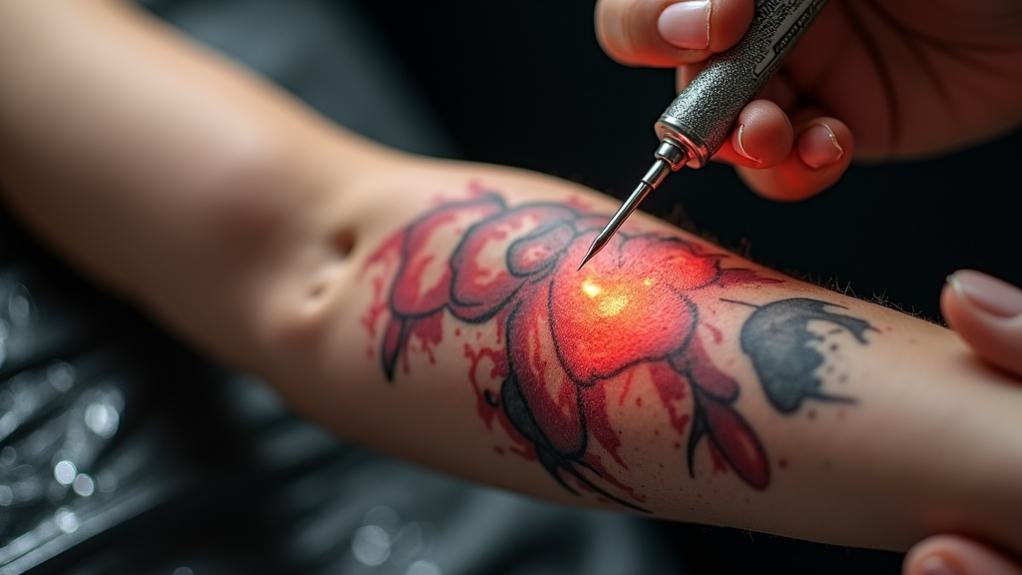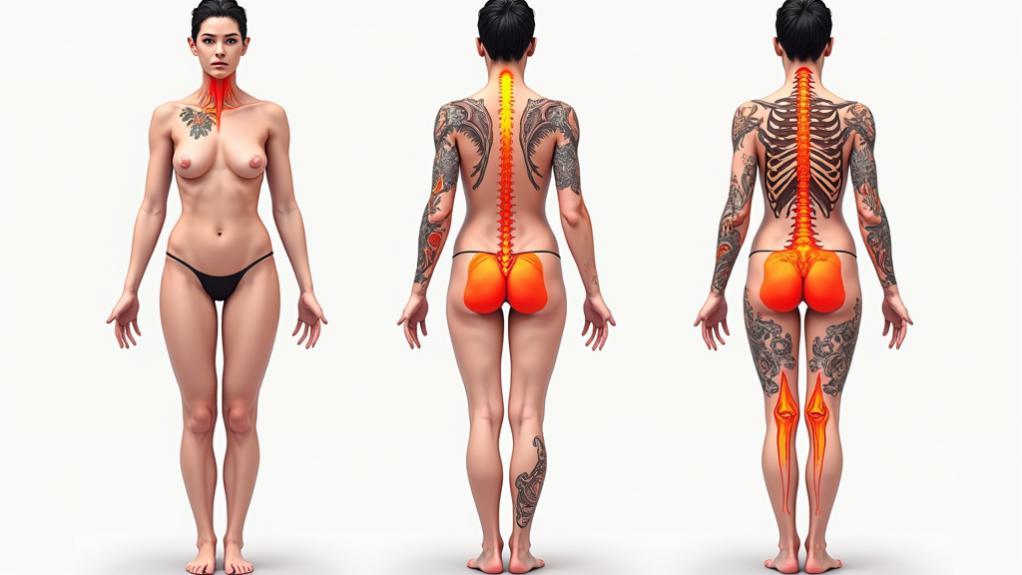Tattoos are permanent designs created by inserting ink into the skin using needles. When considering getting a tattoo, it's natural to wonder about the pain involved.
Some areas of your body, like the ribcage or spine, are notorious for their sensitivity, while others, such as the forearm, might offer a more tolerable experience.
Yes, tattoos do hurt, but the level of pain varies depending on the location on your body. Understanding how these locations affect pain levels can play an essential role in your decision-making process.
In this post, we'll explore the most painful spots for tattoos and discuss ways to minimize discomfort during your tattoo journey.
Understanding Tattoo Pain Factors

When considering a tattoo, your personal pain threshold may significantly influence your experience. Everyone may experience pain differently, so what feels intense for one person may be manageable for another.
The size of the tattoo may also impact pain levels. Larger tattoos may require more time under the needle, potentially increasing discomfort. Additionally, more complex designs with intricate details may take longer and may lead to greater pain.
The tattooing technique used by the artist may affect how sensations are felt. Different pressure applications or needle configurations may result in varying pain experiences. If you're sensitive, it may be beneficial to discuss your concerns with your artist beforehand.
Lastly, your mental state may greatly affect your pain perception. Anxiety or stress may increase your sensitivity to pain, while staying relaxed and calm may help you manage discomfort better.
Understanding these factors may help you prepare for the tattoo experience and make informed decisions that align with your pain tolerance.
Most Sensitive Areas of the Body

Certain areas of your body may be more sensitive to tattooing, which may impact your pain experience.
Here are some of the most sensitive areas to consider:
- Ribcage: May be painful due to thin skin and minimal muscle between the skin and bone.
- Spine: May cause heightened discomfort as nerves and vertebrae are close to the surface.
- Elbows and Knees: May be particularly sensitive due to thin skin and a high concentration of nerve endings.
- Inner Thighs: May experience increased sensitivity from a concentration of nerve endings and less exposure to the elements.
Being aware of these sensitive spots may help you make an informed decision about your tattoo location.
If pain is a concern, you may want to choose a less sensitive area or discuss your options with your tattoo artist.
Comparing Pain Levels by Location

Tattoo pain levels may vary significantly based on the location on your body. Areas like the forearm or outer thigh may be less painful due to thicker skin and more muscle, providing some cushioning against the needle.
In contrast, regions with less flesh or more nerve endings, such as the ribcage, spine, or inner arm, may be considerably more painful. Additionally, spots like the feet, hands, and neck may also cause heightened discomfort due to the proximity of bones and nerve endings.
If you're sensitive to pain, choosing a location known to be less painful may help improve your experience. Understanding these general trends may assist you in making an informed decision about your tattoo placement.
Ultimately, while everyone's pain tolerance is different, the excitement of getting a tattoo may outweigh the discomfort, especially if you love the design.
Tips for Reducing Tattoo Pain

To make the tattooing process more comfortable, consider these tips:
- Stay Hydrated: Drinking plenty of water before your appointment may keep your skin hydrated and make the process smoother, as dehydrated skin may be more sensitive to pain.
- Get Enough Rest: A good night's sleep before your tattoo may improve your pain tolerance, helping your body cope better with discomfort.
- Eat a Light Meal: Having a light meal before your session may stabilize your blood sugar levels, helping you avoid faintness and irritability during the process.
- Use Numbing Cream: Applying a topical numbing cream to the area beforehand may help reduce pain. Always check with your tattoo artist first to confirm it's suitable for your skin.
Personal Experiences and Anecdotes

When it comes to tattoos, pain experiences may vary widely among individuals. Factors such as pain tolerance, tattoo placement, and mental state may influence how one perceives pain during the process.
For instance, areas with thicker skin, like the upper arm, may feel less painful compared to bony spots like the spine or ankles.
Additionally, if you've experienced discomfort from tough workouts or other body art, you may handle the needle better than someone who hasn't.
Your mindset may also play a role; walking in anxious may heighten sensitivity, while feeling excited and relaxed may lead to a more enjoyable experience.
Ultimately, your tattoo experience may be unique, shaped by these various factors.
Frequently Asked Questions
Can You Get a Tattoo While on Pain Medication?
Yes, you may get a tattoo while on pain medication, but it's not always advisable.
Painkillers may dull your senses, affecting your ability to gauge how much discomfort you're actually feeling. This could lead you to underestimate the pain or overestimate your tolerance.
Additionally, some medications may affect your blood clotting, increasing the risk of bleeding during the tattooing process.
It's always best to consult with your tattoo artist and healthcare provider before making a decision.
How Does Tattoo Pain Differ for Each Individual?
Tattoo pain may differ for each individual due to factors like pain tolerance, location, and personal experiences.
You may find certain areas more sensitive, while someone else may feel a different intensity. Your emotional state and the artist's technique may also play roles in how you perceive the pain.
It's all about your body's response and mindset. Ultimately, what may be painful for you may not be the same for someone else, making each tattoo experience unique.
Is There an Age Limit for Getting Tattoos?
There isn't a strict age limit for getting tattoos, but most places may require you to be at least 18.
If you're younger, you may need parental consent.
It's important to contemplate whether you're ready for a tattoo, both mentally and emotionally.
You may want to think about the design and placement carefully, as these choices may have lasting effects.
Ultimately, it's about knowing yourself and understanding the commitment a tattoo may represent.
Can Certain Skin Types Affect Tattoo Pain?
Yes, certain skin types may affect tattoo pain. If you have sensitive skin, you may feel discomfort more intensely.
Thinner skin may also be more susceptible to pain during the tattooing process. Additionally, conditions like eczema or psoriasis may heighten sensitivity, making certain areas more painful.
It's crucial to communicate with your tattoo artist about your skin type, so they may adjust their technique to help minimize discomfort.
What Should I Do if I Feel Faint During a Tattoo?
If you feel faint during a tattoo, let your artist know immediately so they can stop and assist you.
Don't panic; sit or lie down to prevent a fall, and take deep, calming breaths. Hydrating with water or juice may help if possible.
It's important to listen to your body; if you need a break, take one.
Conclusion
To summarize, while tattoos can be painful, knowing which areas are more sensitive can help you prepare for the experience. By considering factors like your pain threshold and choosing locations wisely, you can make your tattoo journey more enjoyable. Remember, everyone's pain tolerance differs, so listen to your body and take breaks if needed. With the right mindset and some pain-reducing strategies, you can focus on the excitement of your new ink instead of the discomfort.







